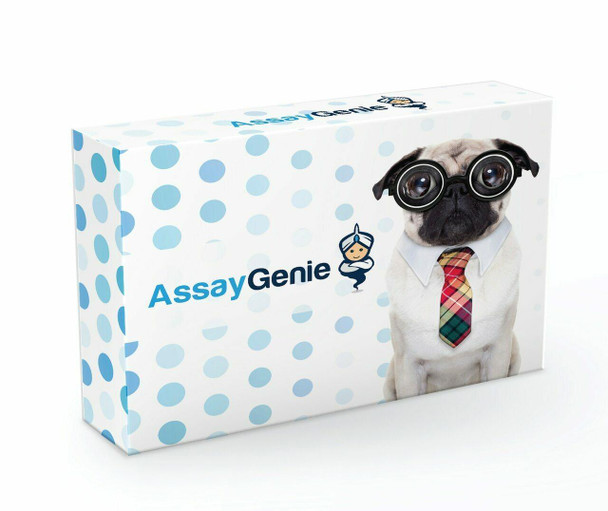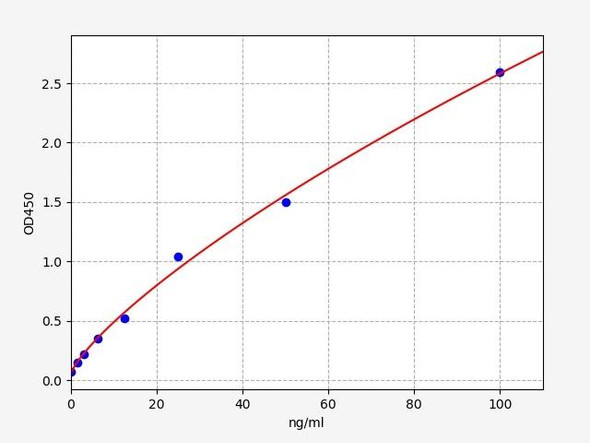Human HbsAg (hepatitis B virus Surface Antigen) ELISA Kit (HUFI08043)
- SKU:
- HUFI08043
- Product Type:
- ELISA Kit
- Size:
- 96 Assays
- ELISA Type:
- Qualitative ELISA
- Synonyms:
- HbsAg
- Reactivity:
- Human
Description
Human HbsAg (Hepatitis B virus Surface Antigen) ELISA Kit
The Hepatitis B virus surface antigen (HBsAg) is a key marker of Hepatitis B viral infection. It is a protein located on the outer surface of the Hepatitis B virus and is involved in viral entry and immune recognition. The presence of HBsAg in the bloodstream indicates an active Hepatitis B infection and can be used for diagnosis and monitoring purposes. The Assay Genie Human Hepatitis B virus surface antigen ELISA Kit is a highly sensitive assay designed for the quantitative measurement of HBsAg in serum, plasma, cell culture supernatant, and tissue samples.
Key Features
| Save Time | Pre-coated 96 well plate | |
| Quick Start | Kit includes all necessary reagents | |
| Publication Ready | Reproducible and reliable results |
Overview
|
Product Name: |
Human HbsAg (hepatitis B virus Surface Antigen) ELISA Kit |
|
Product Code: |
HUFI08043 |
|
Size: |
96 Assays |
|
Alias: |
HbsAg ELISA Kit |
|
Detection Method: |
Qualitative ELISA |
|
Application: |
This immunoassay kit allows for the in vitro quantitative determination of Human HbsAg (hepatitis B virus Surface Antigen) concentrations in serum plasma and other biological fluids. |
|
Sensitivity: |
Contact Technical Support |
|
Range: |
Contact Technical Support |
|
Storage: |
4°C for 6 months |
|
Note: |
For Research Use Only |
Additional Information
|
Recovery |
Matrices listed below were spiked with certain level of Human HbsAg (hepatitis B virus Surface Antigen) and the recovery rates were calculated by comparing the measured value to the expected amount of Human HbsAg (hepatitis B virus Surface Antigen) in samples.
|
||||||||||||||||||||
|
Linearity |
The linearity of the kit was assayed by testing samples spiked with appropriate concentration of Human HbsAg (hepatitis B virus Surface Antigen) and their serial dilutions. The results were demonstrated by the percentage of calculated concentration to the expected.
|
||||||||||||||||||||
|
CV(%) |
Intra-Assay: CV<8% |
Kit Components
| Component | Quantity | Storage |
|
ELISA Microplate (Dismountable) |
8x12 strips |
2-8°C |
|
Negative Control |
1 vial |
2-8°C |
|
Positive Control |
1 vial |
2-8°C |
|
Sample Dilution Buffer |
1 vial |
4°C (Protection from light) |
|
HRP conjugated antibody |
1 vial |
2-8°C |
|
Wash Buffer (20X) |
2 x 25 mL |
2-8°C |
|
Substarte A |
1 vial |
4°C |
|
Substrate B |
1 vial |
4°C (Protection from light) |
|
Plate Sealer |
5 |
- |
Other materials required:
- Microplate reader with 450 nm wavelength filter
- Multichannel Pipette, Pipette, microcentrifuge tubes and disposable pipette tips
- Incubator
- Deionized or distilled water
- Absorbent paper
- Buffer resevoir
Protocol
*Note: Protocols are specific to each batch/lot. For the correct instructions please follow the protocol included in your kit.
| Step | Protocol |
|
1. |
Bring all reagents to room temperature before use. |
|
2. |
Label the sample wells, 2 Negative Controls, 2 Positive Controls and 1 blank well. |
|
3. |
Add 100 uL sample dilution buffer to each well, except blank well. |
|
4. |
Add 10uL sample, Negative Controls and Positive Controls to each well and gently tap the plate to ensure thorough mixing. Seal the plate with a cover and incubate at 37? for 60 min. |
|
5. |
Remove the cover, and wash plate 5 times with Wash buffer and each time let the wash buffer stay in the wells for 1-2 min. |
|
6. |
Add 100 µL HRP- HBsAb to each well, except blank well. |
|
7. |
Seal the plate with a cover and incubate at 37°C for 30 mins. |
|
8. |
Wash: Remove the cover, and wash plate 5 times with Wash buffer. |
|
9. |
Add 50 μl of TMB substrate A and 50 μl of TMB substrate B into each well. Gently tap the plate to ensure thorough mixing. Cover the plate and incubate at 37°C in dark within 30 min. And the shades of blue can be seen in the Positive Controls. Negative Controls wells show no obvious color. |
|
10. |
Add 50µl of Stop solution into each well and mix thoroughly. The colour changes into yellow immediately. |
|
11. |
Read the O.D. absorbance at 450 nm in a microplate reader immediately after adding the stop solution. |
Sample Type
When carrying out an ELISA assay it is important to prepare your samples in order to achieve the best possible results. Below we have a list of procedures for the preparation of samples for different sample types.
| Sample Type | Protocol |
|
Serum |
If using serum separator tubes, allow samples to clot for 30 minutes at room temperature. Centrifuge for 10 minutes at 1,000x g. Collect the serum fraction and assay promptly or aliquot and store the samples at -80°C. Avoid multiple freeze-thaw cycles. If serum separator tubes are not being used, allow samples to clot overnight at 2-8°C. Centrifuge for 10 minutes at 1,000x g. Remove serum and assay promptly or aliquot and store the samples at -80°C. Avoid multiple freeze-thaw cycles. |
|
Plasma |
Collect plasma using EDTA or heparin as an anticoagulant. Centrifuge samples at 4°C for 15 mins at 1000 × g within 30 mins of collection. Collect the plasma fraction and assay promptly or aliquot and store the samples at -80°C. Avoid multiple freeze-thaw cycles. Note: Over haemolysed samples are not suitable for use with this kit. |
|
Urine & Cerebrospinal Fluid |
Collect the urine (mid-stream) in a sterile container, centrifuge for 20 mins at 2000-3000 rpm. Remove supernatant and assay immediately. If any precipitation is detected, repeat the centrifugation step. A similar protocol can be used for cerebrospinal fluid. |
|
Cell culture supernatant |
Collect the cell culture media by pipette, followed by centrifugation at 4°C for 20 mins at 1500 rpm. Collect the clear supernatant and assay immediately. |
|
Cell lysates |
Solubilize cells in lysis buffer and allow to sit on ice for 30 minutes. Centrifuge tubes at 14,000 x g for 5 minutes to remove insoluble material. Aliquot the supernatant into a new tube and discard the remaining whole cell extract. Quantify total protein concentration using a total protein assay. Assay immediately or aliquot and store at ≤ -20 °C. |
|
Tissue homogenates |
The preparation of tissue homogenates will vary depending upon tissue type. Rinse tissue with 1X PBS to remove excess blood & homogenize in 20ml of 1X PBS (including protease inhibitors) and store overnight at ≤ -20°C. Two freeze-thaw cycles are required to break the cell membranes. To further disrupt the cell membranes you can sonicate the samples. Centrifuge homogenates for 5 mins at 5000xg. Remove the supernatant and assay immediately or aliquot and store at -20°C or -80°C. |
|
Tissue lysates |
Rinse tissue with PBS, cut into 1-2 mm pieces, and homogenize with a tissue homogenizer in PBS. Add an equal volume of RIPA buffer containing protease inhibitors and lyse tissues at room temperature for 30 minutes with gentle agitation. Centrifuge to remove debris. Quantify total protein concentration using a total protein assay. Assay immediately or aliquot and store at ≤ -20 °C |
|
Breast Milk |
Collect milk samples and centrifuge at 10,000 x g for 60 min at 4°C. Aliquot the supernatant and assay. For long term use, store samples at -80°C. Minimize freeze/thaw cycles. |
HbsAg Background
Hepatitis B Virus
Hepatitis B Virus (HBV) is a significant viral pathogen that primarily affects the liver, causing a viral infection known as Hepatitis B. It belongs to the Hepadnaviridae family and is highly infectious. HBV can be transmitted through various means, including exposure to infected blood or bodily fluids, sexual contact, and from an infected mother to her newborn during childbirth. Chronic Hepatitis B infections can result in severe liver damage, leading to long-term complications such as liver cirrhosis, liver cancer, and even death
Hepatitis B Virus Surface Antigen (HbsAg)
HBsAg is a protein that is present on the outer surface of the Hepatitis B virus (HBV). It is a crucial component of the viral envelope and is primarily responsible for initiating the immune response during HBV infection. HBsAg is released into the bloodstream during acute and chronic HBV infections, making it a key marker for the presence of the virus.
Importance of HBsAg in Hepatitis B Diagnosis
HBsAg detection is essential for the diagnosis of Hepatitis B infections. Its presence in the bloodstream indicates an active infection, enabling early detection, appropriate treatment, and effective disease management. HBV surface antigens are essential for the formation of HBV viral particles and serve as valuable markers for diagnosing and clinically assessing HBV infections. In cases of chronic HBV infection, the HBV genomes may undergo genetic changes and gather mutations and deletions, resulting in the production of impaired HBV surface antigens. These defective antigens have been observed to play significant roles in the advancement of liver diseases associated with HBV.
HbsAg ELISA Kit FAQs
What is the HbsAg ELISA kit used for?
The Human HbsAg ELISA Kit is specifically designed for the detection and quantification of Hepatitis B surface antigen (HbsAg) in human biological samples. HbsAg is a key marker of Hepatitis B virus (HBV) infection and is commonly used for diagnostic purposes. This ELISA kit allows researchers and healthcare professionals to accurately measure HbsAg levels in various sample types, aiding in the diagnosis, monitoring, and research of Hepatitis B infections.
What are the advantages of using the HbsAg ELISA Kit?
The HbsAg ELISA Kit offers several advantages, including high sensitivity, accuracy, and reproducibility. It provides a user-friendly and reliable method to quantify HbsAg levels in biological specimens, allowing for precise measurements and robust data analysis.
What sample types are compatible with the Fc epsilon RI ELISA Kit?
The HbsAg ELISA Kit is compatible with various sample types, including serum, plasma, cell lysates, and tissue homogenates. It provides flexibility in sample selection, allowing researchers to analyze HbsAg levels in different biological matrices.
What should I do if my assay results are not optimal?
If you encounter any issues or have suboptimal assay results, we recommend contacting our dedicated support team for assistance. They will be available to provide troubleshooting guidance, answer your questions, and ensure you achieve the best possible results with the HbsAg ELISA Kit.






